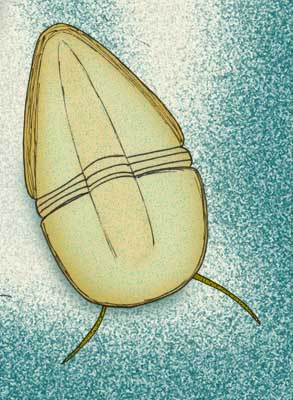Emucaris facts for kids
Quick facts for kids Emucaris fava |
|
|---|---|
 |
|
| Emucaris fava | |
| Scientific classification | |
| Genus: |
Emucaris
|
| Species: |
fava
|
Emucaris fava is an extinct creature that lived a very long time ago. It was a type of arthropod, which means it had a hard outer shell and jointed legs, much like modern-day crabs or insects. This ancient animal looked a bit like a trilobite, another famous fossil creature.
Emucaris fava belongs to a group called Nektaspida. It lived during the Lower Cambrian period, specifically in Cambrian Stage 4. Scientists found its fossils in South Australia. It's the only known species in its genus, Emucaris.
Contents
What's in a Name?
The name Emucaris comes from where its fossils were found. They were discovered in a place called the Emu Bay Shale. The second part, caris, is a Latin word that means "shrimp." So, it's like "Emu shrimp."
The species name, fava, also comes from Latin. It means "honeycomb." This name was chosen because of a cool pattern on its tail shield. It looked a bit like a honeycomb!
What Did Emucaris fava Look Like?
Emucaris fava had a body shaped like an upside-down egg with a pointy end. It was usually between 1.5 and 3 centimeters long. That's about the size of your thumbnail to a small paperclip! Its body was about 1.5 times longer than it was wide.
Its main body part, called the dorsal exoskeleton (its hard outer shell), was only slightly raised. The head shield, or cephalon, was rounded and about half as long as its tail shield.
Between the head and tail, Emucaris fava had four short body segments. These are like the parts of its "chest" area. Its tail shield, called the pygidium, was shaped like a triangle with a rounded end. It even had a small spine at the very tip!
A cool feature of Emucaris was the pattern on its tail. It had many small, equal-sized shapes that looked like polygons, similar to a honeycomb. The edges of its head and tail shields were smooth and didn't have any fancy patterns.
How is Emucaris Different from Kangacaris?
Another ancient creature, Kangacaris, was similar but had some key differences. Kangacaris had only three body segments in its middle section, while Emucaris had four.
The tail shield of Kangacaris was also different. Its main part was wider, about one-third the width of its body. It also had clear segments, unlike Emucaris. Plus, Kangacaris didn't have a spine at the end of its tail. Instead, its tail had 17 evenly spaced ridges along its edge.
Where Did Emucaris fava Live?
Fossils of Emucaris fava have only been found in one special place. They were collected from the Emu Bay Shale. This area is located on Kangaroo Island in South Australia. This tells us that Emucaris fava once lived in the ancient seas that covered this part of Australia.

